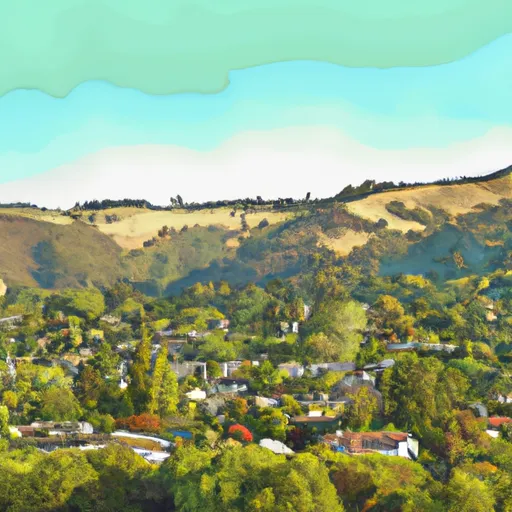-
 Snoflo Premium
Snoflo Premium
Get unlimited access to all our content
With no Ad interruptions! - Start Your Free Trial Login with existing account
Sunol
Eden Index
Climate
7.9
•
Recreation
5.4
•
Community
3.0
•
Safeguard
5.8/10

Sunol, California is a small town located in Alameda County, in the eastern part of the San Francisco Bay Area. The climate in Sunol is characterized by warm, dry summers and mild, wet winters, typical of the Mediterranean climate zone. Summers are generally sunny with temperatures averaging in the 80s°F (high 20s°C), while winters see temperatures ranging from the mid-40s°F (single digits in °C) to the mid-60s°F (up to 18°C), accompanied by occasional rain.
Sunol is surrounded by the scenic beauty of the Sunol Regional Wilderness and is home to several hydrology constituents. The town lies near Alameda Creek, which flows through the region and provides a lifeline for local plant and animal species. The creek is also a popular spot for outdoor activities like fishing, kayaking, and hiking along its banks.
Moreover, the Sunol Regional Wilderness offers various outdoor recreational opportunities. With over 6,800 acres of rugged terrain, visitors can enjoy hiking, horseback riding, and camping. The wilderness area features picturesque trails, including the popular Little Yosemite area, known for its beautiful waterfalls and rock formations.
Overall, Sunol, California offers a pleasant Mediterranean climate, an abundance of hydrology constituents like Alameda Creek, and diverse outdoor recreation opportunities in the nearby Sunol Regional Wilderness.
What is the Eden Index?
The Snoflo Eden Index serves as a comprehensive rating system for regions, evaluating their desirability through a holistic assessment of climate health, outdoor recreation opportunities, and natural disaster risk, acknowledging the profound impact of these factors on livability and well-being.
Climate Health Indicator (CHI): 7.9
Sunol receives approximately
546mm of rain per year,
with humidity levels near 87%
and air temperatures averaging around
16°C.
Sunol has a plant hardyness factor of
10, meaning
plants and agriculture in this region tend to thrive here all year round.
By considering the ideal temperature range, reliable water supplies, clean air, and stable seasonal rain or snowpacks, the Climate Health Indicator (CHI) underscores the significance of a healthy climate as the foundation for quality living.
A healthy climate is paramount for ensuring a high quality of life and livability in a region, fostering both physical well-being and environmental harmony. This can be characterized by ideal temperatures, reliable access to water supplies, clean air, and consistent seasonal rain or snowpacks.
Weather Forecast
Streamflow Conditions
San Francisco Bay
Area Rivers
San Francisco Bay
Snowpack Depths
San Francisco Bay
Reservoir Storage Capacity
San Francisco Bay
Groundwater Levels
Recreational Opportunity Index (ROI): 5.4
The Recreational Opportunity Index (ROI) recognizes the value of outdoor recreational options, such as parks, hiking trails, camping sites, and fishing spots, while acknowledging that climate plays a pivotal role in ensuring the comfort and consistency of these experiences.
Access to outdoor recreational opportunities, encompassing activities such as parks, hiking, camping, and fishing, is crucial for overall well-being, and the climate plays a pivotal role in enabling and enhancing these experiences, ensuring that individuals can engage in nature-based activities comfortably and consistently.
Camping Areas
| Campground | Campsites | Reservations | Toilets | Showers | Elevation |
|---|---|---|---|---|---|
| Alameda County Fairgrounds RV | None | 328 ft | |||
| Sunol Regional Wilderness | None | 529 ft | |||
| Sanborn - Skyline County Park | None | 1,278 ft | |||
| Mt. Diablo State Park | 84 | 1,615 ft | |||
| Grant County Park | None | 1,645 ft | |||
| Del Valle Regional Park | 150 | 760 ft | |||
| Camp Parks Military | None | 351 ft |
Catastrophe Safeguard Index (CSI):
The Catastrophe Safeguard Index (CSI) recognizes that natural disaster risk, encompassing floods, fires, hurricanes, and tornadoes, can drastically affect safety and the overall appeal of an area.
The level of natural disaster risk in a region significantly affects safety and the overall livability, with climate change amplifying these risks by potentially increasing the frequency and intensity of events like floods, fires, hurricanes, and tornadoes, thereby posing substantial challenges to community resilience and well-being.
Community Resilience Indicator (CRI): 3.0
The Community Resilience Indicator (CRI) recognizes that education, healthcare, and socioeconomics are crucial to the well-being of a region. The CRI acknowledges the profound impact of these elements on residents' overall quality of life. By evaluating educational resources, healthcare accessibility, and economic inclusivity, the index captures the essential aspects that contribute to a thriving community, fostering resident satisfaction, equity, and social cohesion.

